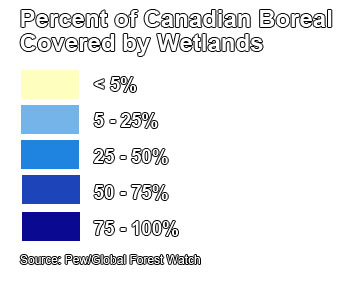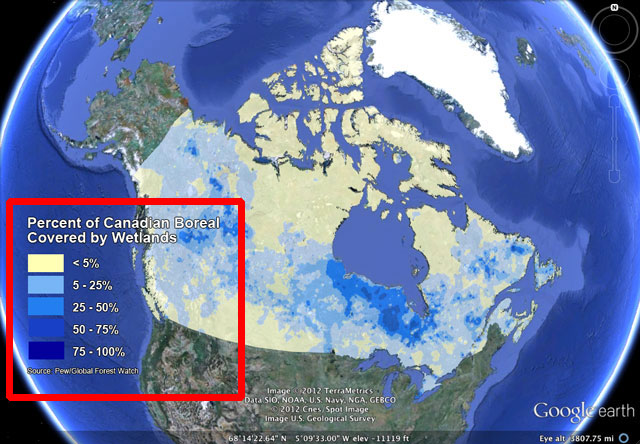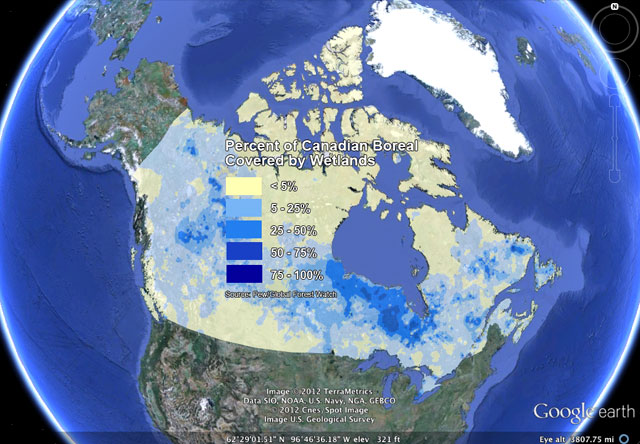upload image to overlay on google earth pro
Adding legends, logos and banners to Google Earth Desktop with Screen Overlays
Tutorial Contents
-
Prerequisites
-
Allow'southward Become Started!
-
Tips
-
Adding a Screen Overlay
-
Irresolute the image
-
Changing the position
-
Screen Overlay Positioning Cheatsheet
-
Tips
-
Discussion and Feedback
-
What's Next
Prerequisites
-
Basic KML code editing (or desire to learn!)
-
A text editing software such every bit Notepad, Notepad++, Text Edit or Text Mate
-
In April 2017, Google Earth on Spider web was released, which puts Earth on the browser. However, for this tutorial, y'all will need World for Desktop installed on your figurer. Download the latest version hither. (Information technology's complimentary!)
In this tutorial, nosotros will employ an example of The PEW Surround Group's Boreal forest Google Earth layer, which you can download here and read virtually in this blog post. Once you open the KML, yous'll notice that it contains several data layers, each accompanied past a legend as well equally logos. We will learn how to add together the legend for the "Canada Wetland" layer pictured below to Google Earth.
In another tutorial, you lot learned how to add an image overlay to Google Earth. What are the differences between a screen overlay and a image (or footing) overlay?
-
Screen overlays are anchored relative to the screen. Image (basis) overlays are anchored relative to the basis.
-
Image (ground) overlays can be added with the toolbar push. Screen overlays are added in the KML code.
-
In the above examples, the legend and logos are screen overlays and the wetland map is a image (footing) overlay.
Let's Get Started!
-
Open Google Earth.
-
If you have already created an image file of a legend y'all would like to employ, host it on a public site or save it on your desktop.
-
If yous don't have an paradigm file, apply our sample legend image file, which is hosted here. This legend epitome has been shared by The Pew Surroundings Group, and is for apply for this tutorial only.

-
Download the sample starter KML (with data provided by The Pew Environs Group) to use during this tutorial, and open information technology in Google Earth (download here).
-
If you want to use your own projection, you can open it in Google Earth.
Tips
-
Get creative with your own fable! You can create a legend in Adobe Photoshop or whatever other image editing software, or consign a legend from ESRI ArcMap as a .jpg. Stick to image file types similar .jpg, .png and .gif. If you want a transparent background to your legend, save it as a .png or .gif, every bit .jpg files practise not support transparent backgrounds.
-
Alternatively, quickly brand a legend using Google Earth Pro's "Salve Epitome" feature
. A customizable legend will be created using the features from the selected layer (please notation, only the selected features from that layer volition appear in your legend). Once yous are satisfied with your legend information technology can be exported every bit an image file. Then crop the fable or have a screenshot to import it equally a Screen Overlay.
-
Stick to prototype file types similar .jpg, .png and .gif. If you desire a transparent groundwork to your legend, save it as a .png or .gif, as .jpg files do non back up transparent backgrounds.
Calculation a Screen Overlay
-
Once you lot have a KML open in Google Earth, open a text editor program like Notepad, Text Edit or Text Mate.
-
Paste the following text into it:
<ScreenOverlay> <name> Legend: Wetlands </name> <Icon> <href>YourURL.html</href> </Icon> <overlayXY ten= "0" y= "0" xunits= "fraction" yunits= "fraction" /> <screenXY 10= "25" y= "95" xunits= "pixels" yunits= "pixels" /> <rotationXY x= "0.5" y= "0.v" xunits= "fraction" yunits= "fraction" /> <size 10= "0" y= "0" xunits= "pixels" yunits= "pixels" /> </ScreenOverlay>This piece of KML code will add the Screen Overlay to your KML.
-
The Wetlands Legend epitome is hosted at the below URL:
https://sites.google.com/site/earthoutreachextfiles/file-cabinet/legend_wetlands.pngIn your text editor, copy and paste the image URL between the HTML tags to replace the text "YourURL.html". Your KML code should at present wait like this:
<ScreenOverlay> <name>Fable: Wetlands</proper name> <Icon> <href> https://sites.google.com/site/earthoutreachextfiles/file-cabinet/legend_wetlands.png </href> </Icon> <overlayXY x= "0" y= "0" xunits= "fraction" yunits= "fraction" /> <screenXY x= "25" y= "95" xunits= "pixels" yunits= "pixels" /> <rotationXY x= "0.5" y= "0.five" xunits= "fraction" yunits= "fraction" /> <size x= "0" y= "0" xunits= "pixels" yunits= "pixels" /> </ScreenOverlay> -
Re-create this text, then switch into your Google Earth window. Click on the KML binder for your project and hitting paste.
The screen overlay entitled "Fable: Wetlands" should appear in your Places Console, every bit in the epitome below.

The screen overlay should announced on Google Earth, as in the image beneath.

Back in your text editor, you can make edits to alter the proper noun, the picture file it references, the placement on the screen and sizing. Or, if you're happy with how it looks, you lot can click on the project binder and save as a KML/KMZ to bundle the fable with the KML layer.
Changing the image
-
To modify to a unlike image, become back to the text editor. Supplant the Icon url with the url of the new prototype you desire to supercede the existing image. If you lot'd similar to replace the image with a file from your desktop, simply replace the url with the path to the file, for case:
For Mac users
<ScreenOverlay> <name>Legend: Wetlands</name> <Icon> <href> /Users/JohnSmith/Partners/Boreal/KML/files/legend_wetlands.png </href> </Icon> <overlayXY ten= "0" y= "0" xunits= "fraction" yunits= "fraction" /> <screenXY x= "25" y= "95" xunits= "pixels" yunits= "pixels" /> <rotationXY x= "0.5" y= "0.five" xunits= "fraction" yunits= "fraction" /> <size x= "0" y= "0" xunits= "pixels" yunits= "pixels" /> </ScreenOverlay>For PC users
<ScreenOverlay> <name>Legend: Wetlands</proper name> <Icon> <href> C:\Projects\Partners\Boreal\KML\files\legend_wetlands.png </href> </Icon> <overlayXY 10= "0" y= "0" xunits= "fraction" yunits= "fraction" /> <screenXY x= "25" y= "95" xunits= "pixels" yunits= "pixels" /> <rotationXY ten= "0.5" y= "0.five" xunits= "fraction" yunits= "fraction" /> <size x= "0" y= "0" xunits= "pixels" yunits= "pixels" /> </ScreenOverlay> -
Re-create this text, so switch back into your Google Earth window. Click on the KML folder for your project and paste the updated text. The screen overlay with your new image should appear on Google Globe.
-
You can change the title identifying your Screen Overlay in the Places Panel past editing the text between
<name></name>.
Changing the position
-
Y'all can change the position of the legend in the Google Earth window by editing the
<overlayXY>and<screenXY>configurations in KML lawmaking. Let's accept a look at the electric current configurations:<overlayXY x="0" y="0" xunits="fraction" yunits="fraction"/> <screenXY x="25" y="95" xunits="pixels" yunits="pixels"/>The
<overlayXY>specifies a point on the overlay image that is mapped to the screen coordinate (<screenXY>).- It requires x and y values, and the units for those values.
- The 10 and y values tin exist specified with the following units:
- Pixels ("pixels") which is the offset from the lower left corner of the prototype in pixels
- Fractions ("fraction"), significant fractions of the image, which is the offset from the lower left corner of the image in fractions (from 0-one)
- The 10 and y positions tin exist specified in different ways—for example, x can be in pixels and y tin can be a fraction.
- The origin of the coordinate system is in the lower left corner of the image.
The
<screenXY>specifies a point relative to the screen origin that the overlay image is mapped to (from the<overlayXY>indicate on the image).- Information technology requires ten and y values, and the units for those values.
- The ten and y values can be specified with the post-obit units:
- Pixels ("pixels") which is the offset from the lower left corner of the screen in pixels
- Fractions ("fraction"), meaning fractions of the screen, which is the get-go from the lower left corner of the screen in fractions (from 0-1)
- The ten and y positions can exist specified in different means—for example, ten tin be in pixels and y can be a fraction.
- The origin of the coordinate system is in the lower left corner of the screen.
Looking at the code sample over again:
<overlayXY ten="0" y="0" xunits="fraction" yunits="fraction"/> <screenXY x="25" y="95" xunits="pixels" yunits="pixels"/>The
<overlayXY>specifies that the bespeak on the overlay paradigm to be mapped to the screen is (0,0) - the lower left corner.The
<screenXY>specifies the identify to which that point on overlay epitome should be mapped is 25 pixels on the ten axis and 95 pixels on the y axis from the lower left screen corner. -
Let'due south change the position of the Wetlands Legend to center of the screen. Switch back to the text editor. Change the units for the
<overlayXY>and<screenXY>to fractions and map the center point on the epitome to the centre indicate of the screen. Later on editing, your KML code should wait like this:<ScreenOverlay> <proper name>Legend: Wetlands</proper noun> <Icon> <href> https://sites.google.com/site/earthoutreachextfiles/file-chiffonier/legend_wetlands.png </href> </Icon> <overlayXY x= "0.v" y= "0.5" xunits= "fraction" yunits= "fraction" /> <screenXY 10= "0.five" y= "0.5" xunits= "fraction" yunits= "fraction" /> <rotationXY 10= "0.5" y= "0.5" xunits= "fraction" yunits= "fraction" /> <size x= "0" y= "0" xunits= "pixels" yunits= "pixels" /> </ScreenOverlay> -
Copy the code in the text editor and switch dorsum to Google Globe. Paste the code into your projection binder. Yous tin plow off or delete the previous fable y'all added. At present you should come across the Wetlands Legend centered in the middle of the screen.

Screen Overlay Positioning Cheatsheet
To position your image in the center of your Google Earth screen...
<overlayXY x="0.v" y="0.5" xunits="fraction" yunits="fraction"/> <screenXY x="0.v" y="0.5" xunits="fraction" yunits="fraction"/> To position your image in the upper left corner of your Google Globe screen...
<overlayXY 10="0" y="i" xunits="fraction" yunits="fraction"/> <screenXY x="0" y="one" xunits="fraction" yunits="fraction"/> To position your image in the upper correct corner of your Google Earth screen...
<overlayXY 10="1" y="1" xunits="fraction" yunits="fraction"/> <screenXY x="1" y="1" xunits="fraction" yunits="fraction"/> To position your image in the lower right corner of your Google Earth screen...
<overlayXY x="1" y="0" xunits="fraction" yunits="fraction"/> <screenXY x="ane" y="0" xunits="fraction" yunits="fraction"/> To position your image in the lower left corner of your Google Earth screen...
<overlayXY x="0" y="0" xunits="fraction" yunits="fraction"/> <screenXY x="0" y="0" xunits="fraction" yunits="fraction"/> Tips
-
To get familiar with changing the placement, sizing, and rotation of a screen overlay, you can exercise by downloading and experimenting with the KML Samples from the KML Reference Guide.
-
If you'd like to change the rotation or size of your paradigm with KML lawmaking, check out the KML Reference Guide for tips on how to use the
<rotation>,<rotationXY>and<size>elements. -
PC users tin can download and utilise David Tryse'south Screen Overlay tool.
Discussion and Feedback
Take questions nearly this tutorial? Want to requite us some feedback? Visit the Google Earth Aid Customs to hash out it with others.
What'south Next
-
See all tutorials.
Source: https://www.google.com/earth/outreach/learn/adding-legends-logos-and-banners-to-google-earth-with-screen-overlays/
0 Response to "upload image to overlay on google earth pro"
Post a Comment